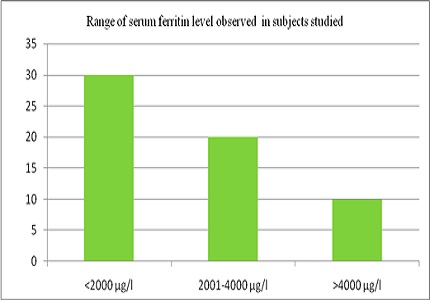Study of Serum ferritin levels in β-Thalassemia major children
Abstract
Background: Thalassemiais one ofthe most commoninherited single-gene disorder in the world. Every year approximately 100,000 thalassemia major children are born all over the world, and there are about 65, 000-67,000β thalassemia major patients in India, with around 9,000-10,000 cases being added every year. Measurement of serum ferritin level can give idea regarding starting of Iron chelation therapy, which will reduce the concentration of serum ferritin and effective in preventing iron induced tissue injury and prolonging life expectancy.
Method: This study was conducted on 60 children between 3 to 17 years, being regularly transfused at department of Pediatrics, Kamala Raja Hospital, Gajra Raja Medical College, Gwalior, for period of 1 year from 2011 to 2012, after taking the informed consent from the parents and explaining them the purpose of study. Detailed history weretaken and serum ferritin level weremeasured by ELIS Abased serum ferritin assay kit.
Results: Serum ferritin level was found to be elevated in all the patients of betathalassemiamajorwithrange from 1050 to 5029 µg/l and with a mean value of 3879µg/l. Out of 60 patients, 30 (50%) patients had serum ferritin level below 2000μg/l,20 (33.3%) patients had serum ferritin value between 2001 to 4000 μg/l and rest 10 (17.7%) patients had values above 4000 μg/l. Mean value of serum ferritin was found to be higher in patients who received frequent blood transfusion.
Conclusion: Majority of the patients had very high ferritin levels, with a mean value of 3879 µg/l. 50% patients had serum ferritin levels more than 2000μg/l. This cut off value reflect either inadequate chelation therapy or non-affordability of parents to purchase oral chelation therapy.
Downloads
References
2. Verma IC, Choudhry VP, Jain PK. Prevention of thalassemia: a necessity in India. Indian J Pediatr. 1992 Nov-Dec;59(6):649-54. [PubMed]
3. Cooley TB, Lee P: A series of cases of splenomegaly in children with anemia and peculiar bone changes. Trans Am Pediatr Soc 1925;37:29 –30.
4. Debaun MR, Vinchisky E. Hemoglobinopathies. In: Kliegman, Behrman, Jenson, Stanton, editors. Nelson textbook of Pediatrics. 18th ed. Philadelphia: Elsevier; 2008.
5. Maheshwari M, Arora S, Kabra M, et al. Carrier screening and prenatal diagnosis of beta-thalassemia. Indian Pediatr. 1999 Nov;36(11):1119-25.
6. Olivieri NF, Brittenham GM. Iron-chelating therapy and the treatment of thalassemia. Blood. 1997 Feb 1;89(3):739-61. [PubMed]
7. Suvarna J, Ingle H, Deshmukh CT. Insulin resistance and beta cell function in chronically transfused patients of thalassemia major. Indian Pediatr. 2006 May;43(5):393-400..
8. Brittenham GM, Farrell DE, Harris JW, et.al. Magnetic-susceptibility measurement of human iron stores. DOI:10.1056/NEJM198212303072703. [PubMed]
9. Arrigo T, Crisafulli G, Meo A, Sturiale M, Combardo F. Micelli, Cucinotta D, De LueaF. Glucose tolerance, insulin secretion and peripheral sensitivity in thalassemia major.JPediatr Endocrinol Metab. 1998; supply 3:863-6.
10. Torres FA, Bonduel M, Sciuccati G, et al. [Beta thalassemia major in Argentina]. Medicina (B Aires). 2002;62(2):124-34.
11. Najafipour F. Evaluation of Endocrine Disorders in Patients with Thalassemia Major. Int J of Endocrinol Metab 2008; 2: 104-113.
12. Ikram N, Hassan k, Younas M, Amanat S. Ferritin Levels in Patients of Beta Thalassaemia Major. International Journal of Pathology; 2004; 2(2):71-74.
13. Lucas GN, Perera BJ, Fonseka EA, et al. De Silva DD, Fernandopulle M. A trial of deferiprone in transfusion-dependent iron overloaded children. Ceylon Med J. 2000 Jun;45(2):71-4. [PubMed]
14. Shah N, Mishra A, Chauhan D, et al. Study on effectiveness of transfusion program in thalassemia major patients receiving multiple blood transfusions at a transfusion centre in Western India. DOI:10.4103/0973-6247.67029.
15. Al Jaouni SK. Survival and disease complication of thalassemia major: Experience of 14 years at king Abdulaziz University Hospital, Jeddah, KSA. JKAU Med Sci 2010;17(1):19–28.doi: 10.4197/med. 17-1.3.
16. Cunningham MJ, Macklin EA, Neufeld EJ, et al. Thalassemia Clinical Research Network. Complications of beta-thalassemia major in North America. DOI:10.1182/blood-2003-09-3167.
17. Choudhry VP, Pati HP, Saxena A,et al. Deferiprone, efficacy and safety. Indian J Pediatr. 2004 Mar;71(3):2136.
18. Riaz H, Riaz T, Khan MU, et al. Serum ferritin levels, socio-demographic factors and desferrioxamine therapy in multi-transfused thalassemia major patients at a government tertiary care hospital of Karachi, Pakistan. DOI:10.1186/1756-0500-4-287. [PubMed]
19. Rehman M and Lodhi Y. Prospects and future of conservative management of beta thalassaemia major in a developing country. Pak J Med Sci, 2004; 20(2): 105 - 112.

Copyright (c) 2018 Author (s). Published by Siddharth Health Research and Social Welfare Society

This work is licensed under a Creative Commons Attribution 4.0 International License.


 OAI - Open Archives Initiative
OAI - Open Archives Initiative


